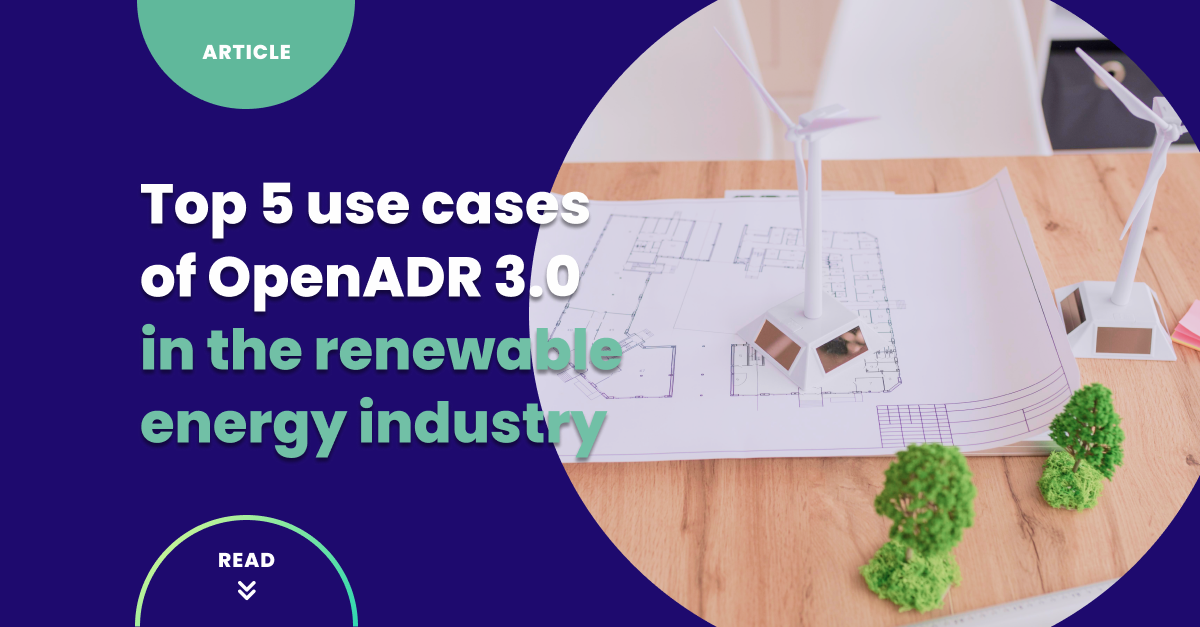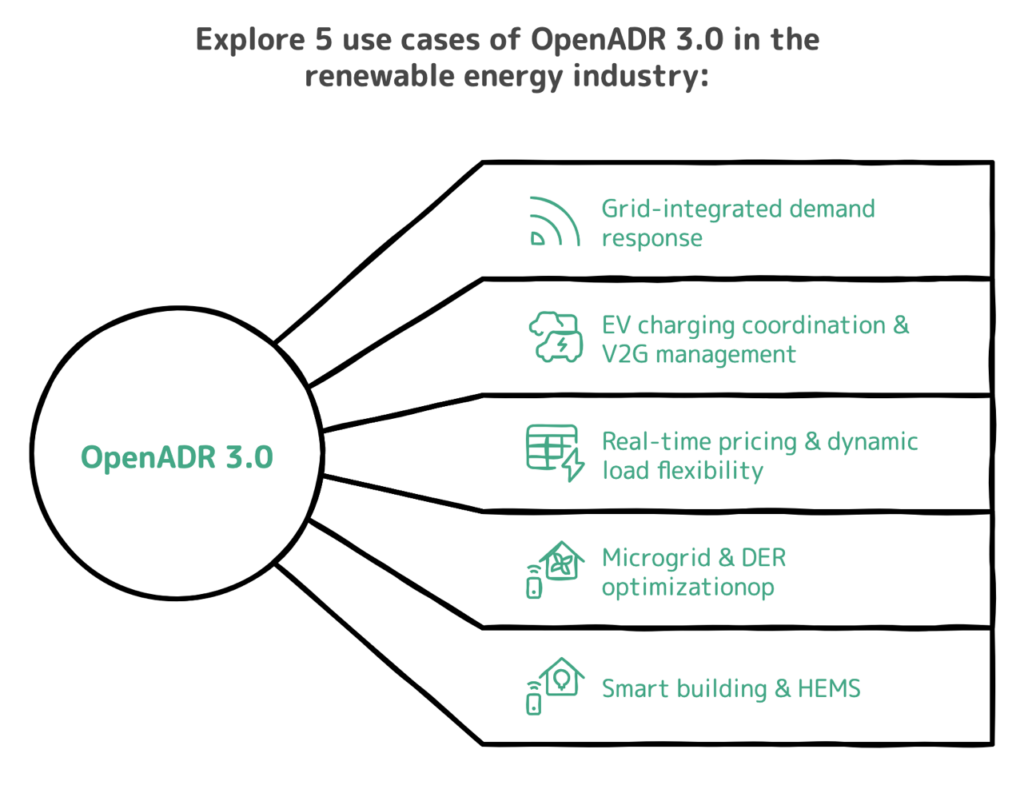Top 5 use cases of OpenADR 3.0 in the renewable energy industry

The transition to a more flexible, renewable-driven energy grid is accelerating, and OpenADR 3.0 is emerging as a key protocol to transform this shift. Designed with modern IT architecture, simplified implementation, and enhanced security, OpenADR 3.0 brings new opportunities for grid operators, utilities, and aggregators to effectively coordinate demand response (DR) and demand flexibility.
Why does OpenADR 3.0 matter?
At its core, OpenADR is a standardized communication protocol that enables automated, real-time energy demand adjustments based on grid signals. The new OpenADR 3.0 simplifies implementation by using RESTful APIs and JSON structures, making it easier to integrate with modern energy management systems. It also enhances security with OAuth and TLS 1.2, improves data structuring for demand response event handling, and streamlines interactions between distributed energy resources (DERs), microgrids, and flexible loads.
For utilities, aggregators, and businesses, this can mean:
- Greater automation – reducing manual intervention in demand response programs
- Faster deployment – integrating demand flexibility into operations in weeks, not months
- Cost-effective energy management – enabling companies to optimize energy usage based on grid conditions
- Improved grid stability – ensuring that renewable energy is efficiently utilized without curtailment
As the energy landscape constantly changes, OpenADR 3.0 is becoming a cornerstone of modern demand response strategies.
In this article, we take a closer look at five real-world use cases of OpenADR 3.0 that are transforming the renewable energy industry. From balancing renewables to smart EV charging, we’ll show how this protocol is making energy systems smarter and more efficient.

1. Grid-integrated demand response (DR) for renewables balancing
With the growing share of solar and wind energy, managing supply fluctuations remains crucial. OpenADR 3.0 builds on the functionality established in version 2.0b by introducing technical improvements, including simplified integration through RESTful APIs and JSON data structures, making it easier for utilities and aggregators to dynamically manage energy demand and ensure grid stability.
- How it works: OpenADR 3.0 enhances the existing capability of sending automated event signals to commercial and industrial users. These signals prompt energy consumers to adjust their consumption patterns more efficiently according to real-time grid conditions.
- Why it matters: While OpenADR 2.0b already allowed businesses to shift energy-intensive processes to periods of high renewable availability, OpenADR 3.0 simplifies implementation and integration, thus enabling broader and more efficient adoption.
- Example: Utilities using OpenADR 3.0 event signals can more seamlessly prompt large commercial buildings to pre-cool HVAC systems during excess solar generation periods, enhancing responsiveness and effectively balancing grid loads.
By making it easier to use and quicker to respond, OpenADR 3.0 helps businesses better match their energy usage to renewable energy availability, reducing the need for fossil fuel-based peaker plants.
2. EV charging coordination & vehicle-to-grid (V2G) management
With more electric vehicles hitting the roads, managing charging demand effectively is essential to avoid overloading the grid. OpenADR 3.0 improves upon the capabilities available in version 2.0b, making smart, flexible EV charging easier to deploy through better integration methods.
- How it works: OpenADR 3.0 simplifies communication through easy-to-use RESTful APIs and JSON data structures. This makes it more straightforward for utilities and charge point operators (CPOs) to send dynamic pricing signals and charging schedules to EV chargers, ensuring charging activities align efficiently with grid conditions.
- Why it matters: While OpenADR 2.0b already enabled smart EV charging, OpenADR 3.0 further reduces implementation complexity. This allows EVs to charge during times when renewable energy is plentiful or even feed energy back into the grid (V2G) during peak demand periods.
- Example: A fleet operator using OpenADR 3.0 can effortlessly schedule EV charging to coincide with overnight peaks in wind-generated energy, lowering costs and relieving pressure on the grid.
Thanks to the easier integration offered by OpenADR 3.0, utilities and charge point operators can more effectively turn EV fleets into reliable, flexible resources for the power grid.
3. Real-time pricing integration for dynamic load management
While OpenADR 2.0b supported demand response mainly through scheduled events, OpenADR 3.0 improves upon this by making real-time pricing signals easier to implement and use, offering enhanced flexibility for the grid.
- How it works: OpenADR 3.0 simplifies the way utilities send dynamic pricing signals directly to smart appliances, industrial equipment, and commercial buildings using RESTful APIs and JSON structures, allowing faster and smoother responses to changing grid conditions.
- Why it matters: Businesses and consumers can now more easily adjust their energy use based on live price signals rather than relying solely on scheduled events. This helps optimize energy consumption, lowering costs and improving overall efficiency.
- Example: A factory receiving real-time pricing signals through OpenADR 3.0 can easily adjust its non-critical production processes during periods of high electricity prices, significantly reducing operational costs.
Thanks to simplified real-time pricing integration in OpenADR 3.0, businesses can more effectively balance their energy use with the actual conditions of the grid, enhancing cost savings and efficiency.
4. Microgrid & distributed energy resource (DER) optimization
Microgrids and distributed energy resources (DERs)—such as solar systems, battery storage, and fuel cells—are crucial for building resilient energy systems. While OpenADR 2.0b already supported basic coordination between DERs and the grid, OpenADR 3.0 makes this integration simpler and more efficient.
- How it works: OpenADR 3.0 streamlines the process of sending real-time grid signals to microgrids and DERs through improved RESTful APIs and JSON data structures, making it easier to adjust energy imports and exports quickly.
- Why it matters: Microgrids can now more easily respond to changing grid conditions—isolating themselves (islanding) during disruptions or optimizing energy exchange with the main grid during normal operation.
- Example: A microgrid operator using OpenADR 3.0 efficiently adjusts energy export during peak demand periods by automatically responding to grid signals, improving reliability and lowering costs.
With simpler implementation provided by OpenADR 3.0, microgrids become even more effective at balancing energy flows, strengthening grid reliability, and reducing operational costs.
5. Smart building & home energy management systems (HEMS)
Smart thermostats, water heaters, and IoT-enabled appliances have become common, allowing buildings and homes to manage energy more effectively. While OpenADR 2.0b already provided the foundation for automating demand responses, OpenADR 3.0 further simplifies integration into smart energy management systems.
- How it works: OpenADR 3.0 improves the ease of implementing automated grid signals through user-friendly RESTful APIs and standardized JSON structures. This helps buildings and homes quickly and effectively adjust energy consumption based on real-time grid signals.
- Why it matters: The enhancements in OpenADR 3.0 make it simpler for consumers and businesses to optimize energy usage automatically, resulting in reduced energy costs and a more resilient power grid.
- Example: A commercial building easily integrates OpenADR 3.0 to pre-cool office spaces during periods when renewable energy is plentiful, automatically reducing HVAC usage during peak demand periods.
OpenADR 3.0’s simplified approach helps smart building and home systems automatically optimize energy use, cutting costs and strengthening overall grid performance.
Why OpenADR 3.0 is important for demand response & energy management
As the needs of energy landscape change quickly, OpenADR 3.0 is emerging as the meaningful standard for demand response and energy flexibility. Unlike older protocols, it is designed for modern energy management systems, ensuring seamless integration, real-time automation, and enhanced security. Whether it’s optimizing EV charging, managing microgrids, or enabling real-time pricing, OpenADR 3.0 provides a scalable, future-proof solution that supports:
- REST API & JSON-based structure – Easier to integrate than XML-based OpenADR 2.0b
- Enhanced security – Supports OAuth and TLS 1.2
- Simplified event handling – Enables real-time demand response execution
- Optimized for grid flexibility – Ideal for EV charging, real-time pricing, and microgrid control
With energy markets becoming increasingly complex, businesses need solutions that are not just compliant with industry standards but also easy to deploy and scale. OpenADR 3.0 is a shift toward a more responsive, efficient, and resilient energy ecosystem.
At Codibly, we help utilities, aggregators, and energy technology providers integrate OpenADR 3.0 with our software solutions. They can reduce deployment time, allowing businesses to implement demand response programs efficiently and maximize the value of renewable energy resources.
Want to explore how OpenADR 3.0 can improve your demand response strategy? Let’s talk.
contact us
Curious how OpenADR 3.0 can transform your demand response strategy?
Whether you’re managing EV charging, microgrids, or real-time pricing -OpenADR 3.0 offers a faster, more flexible way to integrate demand-side solutions.
